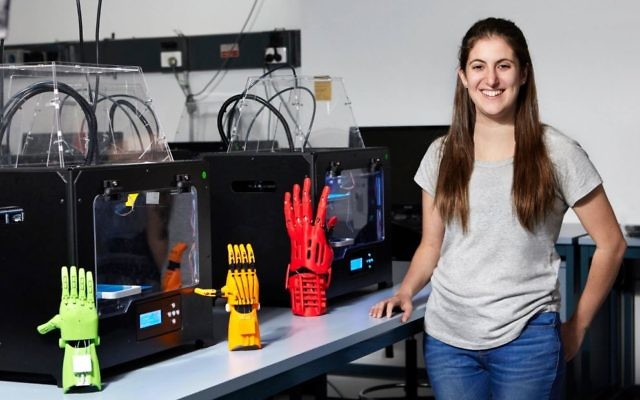Creating helping hands
A biomedicine and engineering student at Monash University is using 3D printing to create prosthetic hands for children who have physical disabilities.
A BIOMEDICINE and engineering student at Monash University is using 3D printing to create prosthetic hands for children who have physical disabilities.
23-year-old Gabi Newman was on the lookout for practical work experience when she was introduced to the Melbourne chapter of e-NABLE, a charity which uses 3D printing to help lower the cost of building prosthetics.
“It’s really cool learning what the printers’ capabilities are,” said Newman, who has been volunteering for e-NABLE for about six months.
“I just keep thinking, wow, there is so much more I can learn. I am at the beginning,” she told The AJN.
She explained that the designs they create are open-source, meaning other people can come and update them.
“I think what’s really important is that anybody could get involved,” she added. “If somebody has access to a 3D printer, it’s not impossible to do.”
Once created, e-NABLE distributes their prosthetic hands pro-bono, although Australian legislation means they cannot provide them to people in Australia without purchasing public liability insurance.
This would cost in the realms of $30,000-$50,000, for which Newman and her colleagues are currently seeking sponsorship.
“Ideally we want to help the Australian community. That’s our goal,” she said, noting that currently they are sending their products to countries including India, the United States and England.
She said she feels strongly about creating prosthetic hands for children because their level of need is different to adults.
While an adult can use a prosthetic for years, a child’s growth means they need new ones regularly. Therefore, making them cheaply using 3D printing provides a huge advantage.
“If you can only get one every couple of years it makes it really difficult,” she said. “What they need at [age] 3 is very different to what they need at [age] 6.”
Newman hopes to get into the area of prosthetics in her future career, and delve into more complex devices.
“It’s quite exciting… I’m enjoying the experience of understanding it a bit more,” she said.
If you are interested in assisting e-NABLE, contact Christopher Ly on 0488 833 388 or email Chris@enablemelbourne.org.
PHOEBE ROTH


comments